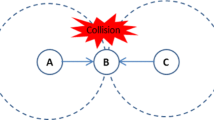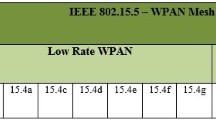Abstract
This paper considers a low power wireless infrastructure network that uses multi-hop communications to provide end user connectivity. A generalized Rendezvous Reservation Protocol (RRP) is proposed which permits multi-hop infrastructure nodes to adapt their power consumption in a dynamic fashion. When nodes have a long-term association, power consumption can be reduced by having them periodically rendezvous for the purpose of exchanging data packets. In order to support certain applications, the system invokes a connection set up process to establish the end-to-end path and selects node rendezvous rates along the intermediate nodes to meet the application’s quality of service (QoS) needs. Thus, the design challenge is to dynamically determine rendezvous intervals based on incoming applications’ QoS needs, while conserving battery power. In this paper, we present the basic RRP mechanism and an enhanced mechanism called Rendezvous Reservation Protocol with Battery Management (RRP-BM) that incorporates node battery level information. The performance of the system is studied using discrete-event simulation based experiments for different network topologies. The chief metrics considered are average power consumption and system lifetime (that is to be maximized). The QoS metrics specified are packet latency and end-to-end setup latency. It is shown that the use of the RRP-BM can increase the lifetime up to 48% as compared to basic RRP by efficiently reducing the energy consumption.
Similar content being viewed by others
References
C.E. Jones, K.M. Sivalingam, P. Agrawal and J.C. Chen, A survey of energy efficient network protocols for wireless networks. ACM/Baltzer Wireless Networks, 7(4) (2001) 343–358.
IEEE, Wireless LAN medium access control (MAC) and physical layer (PHY) Specifications, IEEE 802.11 standard, (1999).
H. Woesner, J.-P. Ebert, M. Schlager and A. Wolisz, Power-saving mechanisms in emerging standards for wireless LANs: The MAC level perspective, IEEE Personal Communications 5 (June 1998) 40–48.
W. Ye, J. Heidemann and D. Estrin An energy-efficient MAC protocol for wireless sensor networks, in: Proc. IEEE INFOCOM, New York, NY (June 2002).
S. Singh and C.S. Raghavendra, Power efficient MAC protocol for multihop radio networks, in: Proc. IEEE PIMRC ’98, Boston, MA, (Sept. 1998).
T. Todd, F. Bennett and A. Jones, Low power rendezvous in embedded wireless networks, in: First IEEE Annual Workshop on Mobile Ad Hoc Networking and Computing (MobiHOC ’2000), Boston, MA. (August 2000).
W. Chen, T. Todd and K.M. Sivalingam, A rendezvous reservation protocol for low power wireless infrastructure, in: IASTED International Conference on Wireless and Optical Communications, Banff, Canada (July 2002).
F. Bennett, D. Clarke, J.B. Evans, A. Hopper, A. Jones and D. Leask, Piconet: Embedded Mobile Networking, IEEE Personal Communications 4 (October 1997) 8–15.
G. Girling, J.L.K. Wa, P. Osborn and R. Stefanova, The design and implementation of a low power ad hoc protocol stack, in: IEEE Wireless Communications and Networking Conference, Chicago (September 2000).
G. Girling, J.L.K. Wa, P. Osborn and R. Stefanova, The pen low power protocol stack, in: 9th IEEE International Conference on Computer Communications and Networks, Las Vegas (October 2000).
C. Rohl, H. Woesner and A. Wolisz, A short look on power saving mechanisms in the wireless LAN standard draft IEEE 802.11, in: 6th WINLAB Workshop on Third Generation Wireless Systems (March 1997).
J. Elson, L. Girod and D. Estrin, Fine-grained network time synchronization using reference broadcasts, in: Proc. Operating Systems Design and Implementation (OSDI), Boston, MA (Dec. 2002).
K. Romer, Time synchronization in ad hoc networks, in: Proc. of ACM MobiHoc, Long Beach, CA (Oct. 2001).
J.R. Jump, YACSIM Reference Manual. Rice University, Department of Electrical and Computer Engineering, 1.2 eds. (August 1992).
J. Kahn, R. H. Katz, and K. Pister, Mobile networking for smart dust, in: Proc. ACM MobiCom, Seattle, WA, (Aug. 1999).
RF Monolithics Inc. http://www.rfm.com (1999).
Panasonic Lithium Coin Data Sheet. http://www.panasonic.com/industrial/battery/oem/(2002).
M. Woo, S. Singh and C.S. Raghavendra, Power aware routing in mobile ad hoc networks, in: Proc. ACM MobiCom, Dallas, TX, (Oct. 1998) pp. 181–190.
J.-H. Chang and L. Tassiulas, Energy conserving routing in wireless ad-hoc networks, in: Proc. IEEE INFOCOM, Tel-Aviv, Israel, (Apr. 2000) pp. 22–31.
D.M. Blough and P. Santi, Investigating upper bounds on network lifetime extension for cell-based energy conservation techniques in stationary ad hoc networks, in: Proceedings of the Eighth Annual International Conference on Mobile Computing and Networking, ACM Press, (2002) 183–192.
Author information
Authors and Affiliations
Corresponding author
Additional information
This work was supported by a grant from the Natural Sciences and Engineering Research Council of Canada and Communications and Information Technology Ontario (CITO). Part of the research was supported by Air Force Office of Scientific Research grants F-49620-97-1-0471 and F-49620-99-1-0125; Laboratory for Telecommunications Sciences, Adelphi, Maryland; and Intel Corporation. The authors may be reached via e-mail at todd@mcmaster. ca, krishna@umbc. edu. The basic RRP mechanism was presented at the IASTED International Conference on Wireless and Optical Communications, Banff, Canada, July 2002.
Subalakshmi Venugopal received her Bachelors in Computer Science from R.V. College of Engineering, Bangalore, India and her M.S. degree in Computer Science from Washington State University. She interned as a student researcher at the Indian Institute of Science, Bangalore, India. Ms. Venugopal is currently employed with Microsoft Corporation in Redmond, WA and is part of the “Kids and Education Group”. Her research interests include low power wireless ad hoc networks.
Zhengwei (Wesley) Chen received the M.E. in Electrical & Computer Engineering Dept from McMaster University in Canada in 2002. He joined Motorola Inc. as a CDMA2000 system engineer in 2000. In 2002, he joined UTStarcom as a manager of the Global Service Solution Department. He is currently in charge of R&D for Advanced Services related to the TVoIP and Softswitch products.
Terry Todd received the B.A.Sc, M.A.Sc and Ph.D degrees in Electrical Engineering from the University of Waterloo in Waterloo, Ontario, Canada. While at Waterloo he also spent 3 years as a Research Associate with the Computer Communications Networks Group (CCNG). During that time he worked on the Waterloo Experimental Local Area Network, which was an early local area network testbed. In 1991 Dr. Todd was on research leave in the Distributed Systems Research Department at AT&T Bell Laboratories in Murray Hill, NJ. He also spent 1998 as a visiting researcher at The Olivetti and Oracle Research Laboratory (ORL) in Cambridge, England. While at ORL he worked on the piconet project, which was an embedded low power wireless network testbed. Dr. Todd is currently a Professor of Electrical and Computer Engineering at McMaster University in Hamilton, Ontario, Canada. At McMaster he has been the Principal Investigator on a number of major research projects in the optical and wireless networking areas. He currently directs a large group working on wireless mesh networks and wireless VoIP. Professor Todd holds the NSERC/RIM/CITO Chair on Pico-Cellular Wireless Internet Access Networks. Dr. Todd’s research interests include metropolitan/local area networks, wireless communications and the performance analysis of computer communication networks and systems. Professor Todd is a Professional Engineer in the province of Ontario.
Krishna M. Sivalingam is an Associate Professor in the Dept. of CSEE at University of Maryland, Baltimore County. Previously, he was with the School of EECS at Washington State University, Pullman from 1997 until 2002; and with the University of North Carolina Greensboro from 1994 until 1997. He has also conducted research at Lucent Technologies’ Bell Labs in Murray Hill, NJ, and at AT&T Labs in Whippany, NJ. He received his Ph.D. and M.S. degrees in Computer Science from State University of New York at Buffalo in 1994 and 1990 respectively; and his B.E. degree in Computer Science and Engineering in 1988 from Anna University, Chennai (Madras), India. While at SUNY Buffalo, he was a Presidential Fellow from 1988 to 1991.
His research interests include wireless networks, optical wavelength division multiplexed networks, and performance evaluation. He holds three patents in wireless networks and has published several research articles including more than thirty journal publications. He has published an edited book on Wireless Sensor Networks in 2004 and edited books on optical WDM networks in 2000 and 2004. He served as a Guest Co-Editor for special issues of the ACM MONET journal on “Wireless Sensor Networks” in 2003 and 2004; and an issue of the IEEE Journal on Selected Areas in Communications on optical WDM networks (2000). He is co-recipient of the Best Paper Award at the IEEE International Conference on Networks 2000 held in Singapore. His work has been supported by several sources including AFOSR, NSF, Cisco, Intel and Laboratory for Telecommunication Sciences. He is a member of the Editorial Board for ACM Wireless Networks Journal, IEEE Transactions on Mobile Computing, Ad Hoc and Sensor Wireless Networks Journal, and KICS Journal of Computer Networks.
He serves as Steering Committee Co-Chair for IEEE/CreateNet International Conference on Broadband Networks (BroadNets) that was created in 2004. He is currently serving as General Co-Vice-Chair for the Second Annual International Mobiquitous conference to be held in San Diego in 2005 and as General Co-Chair for the First IEEE/CreateNet International Conference on Security and Privacy for Emerging Areas in Communication Networks (SecureComm) to be held in Athens, Greece in Sep. 2005. He served as Technical Program Co-Chair for the First IEEE Conference on Sensor and Ad Hoc Communications and Networks (SECON) held at Santa Clara, CA in 2004; as General Co-Chair for SPIE Opticomm 2003 (Dallas, TX) and for ACM Intl. Workshop on Wireless Sensor Networks and Applications (WSNA) 2003 held in conjunction with ACM MobiCom 2003 at San Diego, CA; as Technical Program Co-Chair of SPIE/IEEE/ACM OptiComm conference at Boston, MA in July 2002; and as Workshop Co-Chair for WSNA 2002 held in conjunction with ACM MobiCom 2002 at Atlanta, GA in Sep 2002. He is a Senior Member of IEEE and a member of ACM.
Rights and permissions
About this article
Cite this article
Venugopal, S., Chen, W., Todd, T.D. et al. A rendezvous reservation protocol for energy constrained wireless infrastructure networks. Wireless Netw 13, 93–105 (2007). https://doi.org/10.1007/s11276-006-0799-2
Published:
Issue Date:
DOI: https://doi.org/10.1007/s11276-006-0799-2




